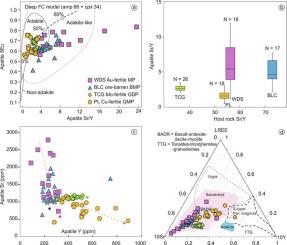当前位置:
X-MOL 学术
›
J. Asian Earth Sci.
›
论文详情
Our official English website, www.x-mol.net, welcomes your
feedback! (Note: you will need to create a separate account there.)
Halogens and trace elements of apatite from Late Mesozoic and Cenozoic porphyry Cu-Mo-Au deposits in SE Tibet, China: Constraints on magmatic fertility and granitoid petrogenesis
Journal of Asian Earth Sciences ( IF 2.7 ) Pub Date : 2020-11-01 , DOI: 10.1016/j.jseaes.2020.104552 Xue Gao , Liqiang Yang , Chenguang Wang , Wenyan He , Xinshang Bao , Shaoying Zhang
Journal of Asian Earth Sciences ( IF 2.7 ) Pub Date : 2020-11-01 , DOI: 10.1016/j.jseaes.2020.104552 Xue Gao , Liqiang Yang , Chenguang Wang , Wenyan He , Xinshang Bao , Shaoying Zhang

|
Abstract Tethyan orogenesis and Indian–Eurasia collision facilitate the development of abundant Late Mesozoic and Cenozoic porphyries and associated Cu ± Mo ± Au deposits in the SE Tibetan plateau. Typical deposits including Beiya with the largest Au reserve of 350 t, Tongchanggou with the largest Mo reserve of 142.5 Mt and Pulang with the largest Cu reserve of 804 Mt were mostly concerned by economic geologists. Porphyries occurred in these three typical deposits were classified as Au-fertile (Wandongshan monzogranite porphyry in Beiya), Mo-fertile (granodiorite porphyry in Tongchanggou), Cu-fertile (quartz monzogranite porphyry in Pulang) and ore-barren (Baliancun biotite monzogranite porphyry in Beiya) systems. In this study, apatite geochemistry from four porphyry systems with distinctive metal endowments was investigated to further constrain magmatic fertility indicators and granitoid petrogenesis. All the studied apatite grains belong to magmatic fluorapatite and are generally wrapped within plagioclase and biotite phenocrysts, suggesting that apatite occurs as early-crystallization phase during crystal fractionation. Apatite grains with porous texture, irregular patchy zoning and secondary rare earth mineral inclusions were eliminated to make the minimal effect of hydrothermal alteration. The F and Cl contents in melt are also estimated based on analyzed F–Cl contents and corresponding F–Cl partition coefficients between apatite and melt under different P–T conditions in this study. Apatite from the Wandongshan (WDS) Au-fertile monzogranite porphyry (MP) has the highest Sr content (average of 1530 ppm) and (F/Cl)melt ratios (44 to 125), indicating that the WDS MP experienced the highest degree of melt fractionation. Additionally, the WDS Au-fertile porphyry is more oxidized than ore-barren, Mo-fertile and Cu-fertile porphyries, evidenced by its highest apatite δEu (0.56–0.83) and lowest δCe (0.98–1.05) values. Rare earth elements (REEs), Y and Sr in apatite were found to be most effective for discriminating magma types. All the apatite grains from typical Late Mesozoic and Cenozoic porphyries in SE Tibet show relatively high Sr/Y (0.5–23.6) and δEu (0.41–0.83) values, pointing to an adakitic affinity of apatite-bearing rock, which is consistent with the whole-rock geochemistry. These porphyries formed under distinctive tectonic settings show distinguishable Clmelt and (F/Cl)melt ratios. The Pulang Cu-fertile quartz monzonite porphyry formed under a subduction setting has relatively high Clmelt contents of 100–1000 ppm and low (F/Cl)melt ratios of 2–22, suggesting derivation of the parental magma from a metasomatized hydrous mantle wedge. Whereas, the WDS Au-fertile MP and Bailiancun ore-barren biotite monzonite porphyry generated under intracontinental setting show low Clmelt contents of 23–180 ppm and variable (F/Cl)melt ratios of 12–125, because F-bearing minerals were decomposing at greater depths under higher pressures during the collision.
更新日期:2020-11-01











































 京公网安备 11010802027423号
京公网安备 11010802027423号